
[ Editor’s Note: It is a treat to introduce this first piece from Jack Heart, somewhat new to the trade and self taught, but you would never know that from what you will see below. We like to do a long piece every now and then, usually a historical one covering a complicated subject over many years.
We all did not have much East Asian history in American schools, so today we have a condensed course in the history of the Pashtuns up to present day. Jack did quite a job pulling all of this together, which taught me a lot.
I did a special magazine layout, as it was both a challenge and fun to go hunting for the right mix of images to help bring Jack’s historical tour to life. I hope you enjoy. I sure did… Jim W. Dean ]
__________
Press TV asks – “What do you think is the root cause of the violence in Kashmir and the ongoing crisis there? How do you think the crisis can come to an end?”
… by Jack Heart … with Jim W. Dean editing
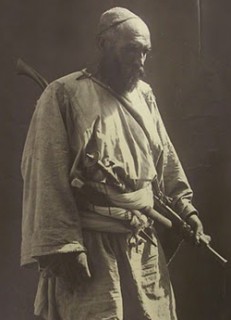
At the end of the summer of 1947, after centuries of exploitation by the British, Colonial India had finally broken free.
Through the Indian Independence Act ratified by King George on the Sixth of July in that same year the former colony became Islamic Pakistan in the predominantly Muslim northwest and Hindu India in its heartlands to the southeast.
The air had just began to turn crisp and the leaves in the apple orchards were showing their first hint of color in the high misty valleys of Kashmir, India’s enchanted northern crown. It was in this idyllic storybook setting that the inhabitants of the Baramulla district awoke to find themselves under attack.
Hordes of hereditary warriors from Khyber Pakhtunkhwa, a neighboring area claimed by Pakistan but traditionally controlled by the Pashtun tribe, rolled into the countryside from out of the west.
The Pashtun had declared their intentions for the entire Indian subcontinent. They were not about to confine their activities to their traditional battlefield in Afghanistan and the northwest frontier of Pakistan.
The British had not been gone a month before the Pashtun embarked on their interminable quest of war for God and Pakhtunwali. They would drag the fledgling Pakistani army, still commanded by recalcitrant British officers, into an attack which would end up carving out about forty percent of Kashmir for Allah, Pakistan and their self appointed partners; the Pashtun Tribe.
The area appropriated included five of the highest peaks in the world. Perhaps upon those peaks the Pashtun will find Zun the God of the mountain tops, the mysterious God before Allah in whose name the Pashtun waged their perpetual war.
Almost twenty years later on the other side of Pakistan, by the shore of the Arabian Sea, lay the rapidly expanding city of Karachi. Millions of Mohajirs, Muslim refugees from India, had settled in the city since Pakistan’s independence.
Linguistically and ethnically isolated from the rest of the Sindhi speaking providence of Sindh, the Mohajirs had thrown their support to Mohtarama Fatima Jinnah the sister of Muhammad Ali Jinnah the founding father of Pakistan. It appeared the almost unanimous vote from the two and a half million residents of Karachi might carry Jinnah to victory in the country of then 45 million people.
But her opponent in the early 1965 election was military despot Muhammad Ayub Khan and he wasn’t ready to relinquish the control he had held over Pakistan since 1958. With the help of his son; Gohar Ayub Khan, he flooded the Mohajir neighborhoods of Karachi with truck loads of axe-wielding Pashtun tribesmen imported from Khyber Pakhtunkhwa.
_________

Pakistan’s claims to Khyber Pakhtunkhwa are nebulous at best. Pakhtunkhwa literally means “area of the Pashtun” in the Pushto language.
It is a place that has always been the designated area, immune from governing, where the Pashtun kill each other when they don’t have guests to kill.
It was a field trip of mayhem and murder by the seaside as the tribesman ran amuck in the streets of Karachi using axes and knives to maim and slaughter hundreds of Mohajirs. Fatima Jinnah would lose to Ayub Khan in the blood soaked electoral results.
The legacy of a military dictatorship in Pakistan would last at least until 2008 when strongman Pervez Musharraf resigned under intense pressure from Britain and America over his impending impeachment trial. Asif Ali Zardari is the current President of Pakistan.
In December 2011, ex-CIA official Bruce Reidel said in Washington DC, amid speculation over Zardari’s future, that he believed “the creeping establishment of Pakistan’s fifth military dictatorship is underway right now.” On January 15, 2013, Pakistan’s supreme court ordered the arrest of Zardari.
It is believed they are planning to accomplish this through the military who will then appoint its own President establishing yet another military dictatorship de jour in Pakistan. Both the ethnic rioting in Karachi, a fifth military dictatorship, and the war between India and Pakistan over Kashmir, still simmer today.
They are the Pashtuns gift to the Indian subcontinent. Meanwhile, history’s eternal warrior wages yet another war with yet another super power on the home front in Afghanistan. This time its against America. As the time before, against the Soviet Union, the Pashtun call themselves the Taliban which in Pashto, the Eastern Iranian language of the Pashtun, means student.
Eighty five percent of the Taliban is Pashtun. They would like the world to believe they are students of Islam but history tells a far darker tale of what the Pashtun’s curriculum is and what it has always been.

Ostensibly the Pashtun heartland, Afghanistan, became a country in 1709, but it has always been a country, by default.
In all of recorded history, no power on earth has been able to conquer and hold it. Over two millennia ago, the Pashtun were known as the Bactrian in the West. The first mention of them in western history was made in Greek. It was in reference to the suicidal charges they made against the Macedonian king, Antiochus.
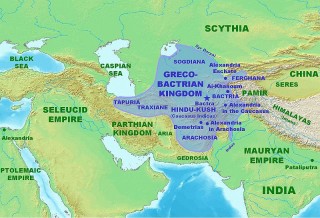
Although the Bactrians lost the first battle, they just kept coming back until the Macedonians were overwhelmed.
According to the historian Apollodorus of Artemita, writing a hundred years before the common era, the Bactrians went on to conquer an even larger portion of India than Alexander himself did: “the revolt grew so powerful on account of the fertility of the country that they became masters, not only of Ariana, but also of India.”
Archeological artifacts indicate the Kushan Empire was founded in Bactria in the first century of the Common Era by Kujula Kadphises.
At the height of its influence, the Kushan Empire encompassed much of the Indian subcontinent. Justin, writing around the third century of the common era, in ‘Epitome of the Philippic History of Pompeius Trogus’ calls it: “the most powerful dominion of Bactria, peopled with a thousand cities.”
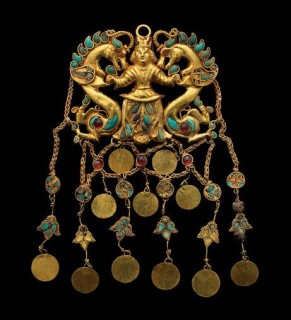
Many believe the Pashtuns are the legendary Aryans (àrya in Sanskrit; meaning noble, loyal to God). The Rig Veda refers to the Pakthas along with the Jadu, Kuru, Sivas, and Bhalanases, as the àrya tribes that fought unsuccessfully against King Sudàs in the Battle of the Ten Kings.
Some scholars debate this and consider it just a linguistic mistake that Pakthas and Pashtun sound similar, but the Pashtun people themselves are firmly convinced, even naming Afghanistan’s air line; Ariana Afghan.
Strabo’s The Geography, written two thousand years ago clearly states “Apollodorus says that Bactriana is the ornament of Ariana.”
When there were outsiders, Afghans fought them. When there were no outsiders, Afghans fought among themselves.
The Kushan Empire fragmented in the fourth century, and for a few centuries the Pashtun fought each other and the Hephthalite’s, or White Huns, that were sweeping in from Central Asia.
Later the Pashtun held their ground for hundreds of years against the the hordes of Mohammed as the prophets armies swept everything else before them.
The tribesmen had their own God, a God they called Zun, depicted as a golden idol with eyes of rubies. When the Pashtun could hold out no more they accepted the God of Islam.
At the turn of the tenth century, the Pashtun came under the rule of the legendarily ferocious Turkish prince, Mahmud of Ghazni, his successors were just as malevolent.
The Ghaznavid dynasty was overthrown in the middle of the twelfth century, when the tribesmen could no longer take their insults. They were replaced by the Pashtuns own version; the Ghurid dynasty, which invaded and occupied what is now Turkey.
The Ghurids proceeded to build their edifices with bricks that were carried on the backs of the enslaved Ghaznavid noblemen. Its said the mortar was mixed from their blood.
The Pashtuns vengeance would last about a generation. In the early part of the thirteenth century, the Pashtun’s Islamic fervor would bring genocide from no less formidable an adversary than Genghis Khan himself. When the Khwarezmian Shah slaughtered Genghis Khan’s emissaries in Iran the Pashtuns would pay the price. But initially they routed his expeditionary force.
The Pashtun could not hold the field because immediately after their victory they started fighting amongst themselves over the ownership of a horse. Genghis Khan was not used to losing battles, so he resolved to systematically exterminate the Pashtun.
In the aftermath the Mongols’ occupation, even he was appalled at the level of violence he brought to the land of the Pashtun. It is said upon his old age that he confided in close friends that he thought he might have gone too far in what is now Afghanistan. Nevertheless, the Pashtun survived, they always do.
When the blood lust of Genghis Khan was finally satiated the tribesman waged more war against Genghis Khan’s Muslim descendant; Tamerlane. The tribesman then incarnated himself as a warrior poet; Khushal Khan Kattak, and fought the mighty Mongol empire for two more generations.
_________

The Pashtun stood against the British Empire three times at the height of that empire’s power. The first war lasted from 1839-1842.In one incident alone twelve thousand civilians and thirty five hundred English and Indian soldiers were massacred.
Major General William George Keith Elphinstone was escorting civilians through thirty miles of mountain passes along the Kabul river and had been given safe passage by the tribesman.
It’s said that only one man survived. The second war lasted from 1878 to 1880 and featured the battle of Maiwand, a battle made famous by poet; Rudyard Kipling. At Maiwand the tribesman inflicted a devastating defeat on the British, killing almost half their soldiers from a force of twenty five hundred.
The third war was in 1919. It was initiated by the tribesman over the Indian judicial systems perceived mistreatment of a sixteen year old girl. It ended with the Treaty of Rawalpindi in which the British finally recognized Afghanistan’s independence leaving Amir Amanullah Khan as the undisputed ruler of Afghanistan.
Amanullah Khan set about on a mission attempting to modernize Pashtun tribal life, pushing through Judicial reform, women’s rights, and resting control of the military from the Mullahs. Although he was popularly supported in urban areas of Afghanistan he was deeply resented by the rural chieftains who ignited the Khost Rebellion from 1923 to 1924.
The rebellion eventually forced his abdication and exile in 1929. He was succeeded by a bandit; Bacha-i Saqqa. Saqqa was in turn hung by Mohammed Nadiq Shah. Nadir Shah ruled from 1929 to 1933 when he was assassinated by a schoolboy; Abdul Khaliq Hazara, at a high school graduation ceremony. Hazara’s family and friends were tortured, raped and killed, even though he acted alone.

After undergoing many months of interrogation and torture himself, Hazara was given a public execution.
The executioner asked Hazara which finger he pulled the trigger with, which eye he took aim with, and which foot he stepped forward with, then gouged out his eye and cut off the corresponding body parts. After dismemberment Hazara’s body was shred in pieces by a bayonet.
Nadir Shah was succeeded by his son Zahir Shah who introduced many reforms and ruled peacefully till 1973 when he left the country for medical treatment and was displaced by his cousin; Daoud Khan.
With the help of the military Khan abolished the monarchy and ruled for five more years until he was murdered by the communists in 1978. Afghanistan was invaded by the Soviet Union in 1979. The USSR would leave battered and defeated in 1989.
History bares irrefutable testimony that the Pashtun is hardwired for aggression and his immutable code of ethics; Pakhtunwali, morally equips him with the temperament of a rabid pit bull on steroids. The Pashtun is obligated by Pakhtunwali to avenge any wrong that has ever been done to him, and that does mean ever.
In Pashto this tradition and cultural requirement is called “Badal.” Many Americans labor under the mistaken belief that the saying ‘revenge is a dish that is best served cold’ was invented by the Sicilian Mafia. It was not. It is an ancient Pashtun proverb. It is for this very reason that the northern half of India will never be safe.
The Pashtun, many from the Yusufzai and Bangash tribal branches, had ruled for centuries in northern Indian lands called the Rohilla States or Rohilkhand. The Rohilla States extended to the city of Patna far in the east of India. The area that constituted them is currently known as Uttar Pradesh and is part of India. It has a population of over 200 million people.

The Pashtun had first come to India during the Ghurid dynasty and stayed on as mercenaries in the service of the Sultans of Delhi. Many became horse traders and wealthy landowners.
Parlaying their military talents with the disintegration of the Mughal Empire these itinerant warriors carved out their own independent principalities.
They were driven from these rich agricultural lands by an alliance of the British under the command of Colonel Alexander Champion and an army of Sikhs, Hindus and Shiite Muslims, under the command of Persian Shiite; Shuja-ud Daulah. The Sunni Pashtun were under the command of; Hafiz Rahmat Khan.
The two sides met in an apocalyptic battle on April 23, 1774.
The Pashtuns were badly outnumbered and outmatched but they were game; they are always game. Iqbal Husain the historian and author of ‘The Ruhela chieftaincies. The rise and fall of Ruhela in India in the eighteenth century gives an account from a British officer saying,
“It is impossible to describe a more obstinate firmness of resolution than the enemy displayed; numerous were their gallant men who advanced and often pitched their colors between both armies in order to encourage their men to follow them.”
The battle ended when Hafiz Rahmat Khan was struck in the chest by a cannonball killing him instantly. The Pashtun dispersed from a battlefield where thousands of their fellow tribesman lay dead.
What happened next would give rise to centuries of seething Pashtun hatred. Colonel Champion and Shuja-ud Daulah remained on the battlefield for three days dispensing raiding parties to loot, pillage, and burn Pashtun settlements throughout the countryside. Many of the Pashtuns that were not killed outright, but were forced to convert to Sikh and Hindu.
Iqbal Husain describes Colonel Champion and Shuja-ud Daulah’s actions as “ethic cleansing.”As their code Pakhtunwali dictated the Pashtun never forgot this and it became immortalized in their folk songs and poems.
The incident would give rise to Ahmad Shah and his followers. Ahmad Shah was a early nineteenth century messianic figure from the Rohilla states who taught and waged a permanent Jihad against “the bondage of the infidels.”
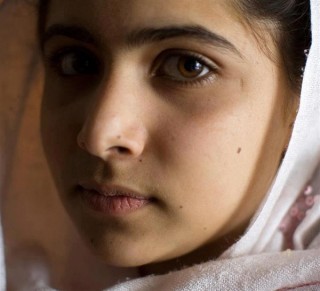
It was said that when he was a child his mother would help him organize mock skirmishes between the children of the villages with one side being the true believers and the other the infidels.
Charles Allen author of ‘God’s Terrorists: The Wahhabi Cult and the Hidden Roots of Modern Jihad’ writes Ahmad Shah’s followers were a Mahdis cult who proclaimed themselves “Mahdawis” or one who claims to know the secret meaning of the Quran. He notes they “always carried swords and shields, and all kinds of weapons.”
There would be war upon war of reckoning with the British and Sikhs and an abiding hatred kindled for the Hindus and Shiites. Sayed Ahmad Shah would be deposed by the Pashtun themselves when he tried to stop them from selling their daughters into marriage.
Eventually the Sikhs would “martyr” him. But his message of jihad against the infidel would live on when his students founded Deobandism and laid the foundation for todays Taliban. Pashtun “Badal” wearing its by now familiar disguise of Islamic fanaticism would result in the Sepoy Rebellion in 1857.
The rebellion came within a hair’s breadth of expelling the British from northern India and it led to the dissolution of the British East India Company in 1858, when British Parliament took direct control of Indian affairs.
Charles Allen insinuates that the Sepoy Revolt only failed because the Pashtuns of Sittana and Patna refused to cooperate with the mutineers from Oudh, because Oudh’s long dead Shiite leader Shuja-ud Daulah had perpetrated the ethnic cleansing in Rohilla almost a century before.
An Islamic school that was spawned in the Sepoy Revolt reopened in 1866 in the small country town of Deoband about 80 miles northeast of New Delhi. The school taught a blend of Sunni adherence to a Shari’a (law and moral code) that remained immutable after the tenth century.
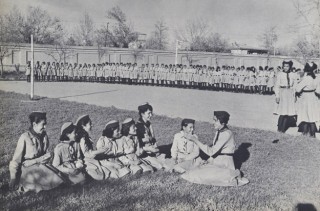
The students of the Deoband school blended their dark age philosophy with the Sufi mysticism espoused by Sayed Ahmad Shah and the mystic who had influenced him; Shah Wali Ullah.
Deobandi madrassas (schools) sprung up all over the Indian subcontinent but particularly among the Pashtun.
In 1919, the Dar-al-Ulum (sacred madrassa) at Deoband established a political wing called the Jamiyatul Ulama Hind. In 1970 Jamiyatul Ulama Hind won the largest number of national assembly seats in Khyber Pakhtunkhwa and the second largest number in Balochistan, another Pashtun stronghold.
In 1971, the election would result in Civil war in Pakistan between the east and the west when the military president, upon learning of the election results, asked Zulfiqar Ali Bhutto as Sindhi chairman of the Pakistan Peoples Party to form a government. The Jamiyatul Ulama Hind is now the primary opposition to the moderate Pakistan Peoples Party in Pakistan.
According to The Heritage Foundation nearly 65% of the total madrassas in Pakistan are run by Deobandis. In India the hard-line Deobandi school of Islam has the support of only around 20% of India’s Muslims and the more moderate Sufi Barelvi school has a following of over 75 percent. But as any Muslim Indian can tell you it is the Deobandi school which is fawned over by India’s congress.
At the end of march 2011 in what can only be described as a shocking display of India’s cluelessness to the dangers of radical Islam India rolled out the red carpet for a state visit from Abdur-Rahman Al-Sudais, the mad Wahhabi Mullah from Saudi Arabia, whose hate filled sermons are legendary throughout the Islamic world.
The arrival of Al-Sudais as the first-ever imam of the Haram to come to India was intended to impress Indian Muslims with the stability of Saudi Wahhabism and its solidarity with the Deobandism of the Taliban.The Jamiat Ulama-i-Hind requested that when he goes to the parliament, Al-Sudais should be spared a security examination.
Al-Sudais has been designated by the JUH as the supreme world authority for Sunni believers and therefore above the supposed indignity of a security check. At the time of Pakistan’s creation the Deobandis, landlocked in mostly Hindu India, worked furiously to spread their Naqshbandiyya-Sunni-Hanafi-Deobandi interpretation of Islam outside of India.
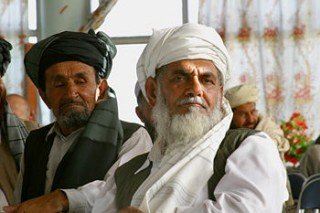
The Taliban is a direct result of those efforts. According to Deobandi teachings it is everybody else’s fault that Islam lags behind the rest of the world in practically every criteria of civilization.
When the British finally left the Deobandi’s shifted seamlessly from demonizing British imperialism and exploitation to demonizing the Indian Hindus who they said were oppressing Muslims in the disputed area of Kashmir.
Later when the Soviets invaded Afghanistan in 1979, the Deobandis demonized communism and when the Soviets left and the Americans entered they seamlessly switched to demonizing U.S. secularism.
On the behest of his God the Pashtun fights total wars. As a result, many of the most important relics of early civilization have been disappearing into private collections or, because they offensive to the Pashtuns medieval mentality, are being destroyed outright.
Right after the Kabul museum was hit by a “stray” Taliban rocket in 1993, the looting began. In 2001 it reached a crescendo in the Bamiyan Valley in the Hindu Kush mountains. When the “Students” blew up the world’s two largest standing Buddhas, fifteen hundred years old each, one of them 165-ft tall.

After the U.S. deposed the Taliban, through the Northern Alliance in November 2001, Afghanistan became a grave robbers paradise.
In refugee camps on Pakistan’s Northwestern frontier collectors take shopping forays through the camps and place orders with refugees to be passed on to local warlords in Afghanistan.
These warlords openly brag that the collections displayed in their living rooms rival those displayed in the Kabul museum.
One private collector named Martin Schøyen managed to smuggle 1400 priceless ancient Buddhist manuscripts out of Afghanistan and into his farmhouse in Norway.
The area encompassing Bactria, and where the Pashtun now live, was once called Gandhara by the indigenous people. Gandhara was an important seat of Buddhist learning and the Scholars of Gandhara traveled east to India and China where they were influential in the development of early Mahayana Buddhism. The inhabitants of Gandhara were first described in the Vedas thousand of years ago as cosmic beings.
The thirty second book of the Avatamsaka-siitra, now available only in Chinese and Tibetan translations says “In Afghanistan there is a dwelling place called ‘Producing Compassion’ where enlightening beings have lived since ancient times.” Some mystics have speculated that this is where the legendary subterranean kingdom of Agartha and the seat of the Melchizedek is located.
The European legend of Prester John, a great Christian civilization concealed in the east, is often cited as evidence. Gandhara is the only region which figures in the seven notes of Indian music: re, ga, ma, pa, dha, ni, and sa.
Ga is Gandhara, symbolic of the vigor which flows through the blood of time. It eternalizes the youth of Gandhara.

As long as twelve thousand years ago, Zarathustra founded the earliest religion based on a fixed scripture. He is said to have been born in Bactria.
The capital of Bactria was Bactra, known to have had a sanctuary dedicated to the Zarathustrian Goddess of water and fertility; Anahita. In the Avesta, the sacred texts of the Zarathustranism, Bactra was called “the town with the high-lifted banners.”
Before it was named Bactra by the Greeks, the city was named Balkh. Balkh is one of the oldest cities in the world.
Balkh is considered to be the first city to which the Indo-Iranian tribes migrated from the North of the Oxus and Amu River. Archeologists have dated the beginning of Balkh civilization to five thousand years ago.
But to the south of Balkh in what is now Balochistan, lay Mehrgarh where eleven skeletons have been unearthed with dental drill holes in their teeth. The skeletons have been dated to be between 7500 and 9000 years old. A report in the April 6, 2006 issue of Nature said Italian researchers working at a cemetery discovered drill holes on at least eleven molars from people buried in a cemetery of Mehrgarh.
If nothing else, the land of the Pashtun may be the most important archeological site in the entire world, but what Afghanistan is really rich in is opium. In Afghanistan, the per hectare poppy yields are more than three times greater than in Burma, the traditional supplier of the world’s opium before the 21st century.
Forty-eight and a half kilograms of opium per hectare are yielded in Afghanistan, as compared to 15 kilograms per hectare in Burma. Two thousand five hundred and seventy-five tons of opium were produced in Burma in 1993. By 2007, Burma’s opium output would be down to two hundred and seventy tons.
But in the meantime Afghanistan’s output, down to almost nothing by 2001 under the Taliban, steadily increased under American occupation, reaching over 8000 tons by 2007. By 2009, Afghanistan controlled the production of over 90% of the world’s total opium supply.
In 1995, the Unocal Corporation signed an $8 billion deal with Turkmenistan, a country that borders both Afghanistan and Iran, to construct an oil and gas pipeline. The eight billion was part of a larger deal for two pipelines intended to transport oil and gas from Turkmenistan through Afghanistan and into Pakistan.
Early in 1998 in Washington DC, testimony was given by John J. Maresca vice president of international relations for Unocal to the House Committee on International Relations, subcommittee on Asia and the Pacific. Maresca claimed there was anywhere between 60 and 200 billion barrels of oil and 236 trillion cubic feet of natural gas in the Caspian region.

As early as 1994 the American Petroleum Institute had been wildly asserting that there was 659 billion barrels of oil in the region.
Maresca estimated that with a pipeline through Afghanistan 870,000 barrels per day, the then current production of oil, could be increased to 200 million barrels a day by 2010.
In the wake of 9/11 THE PASHTUN CODE by Isabel Hilton, an article published in the The New Yorker at the end of 2001, may have been the last real attempt at professional Journalism on Afghanistan by the wests main stream media.
In a first hand account Hilton paints a tragic picture of a geographically untamable land ruled by tribal loyalties and warlords, where making rocket launchers is a cottage industry and the Taliban is viewed as the only functional force of law and order.
Although Hilton is sympathetic to the Pashtun to the point of naivety she minces no words when she writes:
“Domestic violence is regarded as the main entertainment of village life.”
She paraphrases cultural anthropologist Cherry Lindholm, who studied the Pashtun, describing their family life as a small scale internecine war with the strong learning from infancy to dominate the weak.
She writes that in Pashto “The term for a husband who does not beat his wife is “a man with no penis.”” Women’s rights are traditionally nonexistent in Pashtun culture.
Woman have always been treated as a form of property, like land and wealth. They cannot inherit nor, according to the Taliban’s Deobandi interpretation of the Quran, learn to read and write. They are usually married off by arrangement at the age of fifteen.
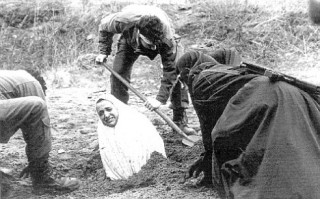
In fact under the Taliban women were regularly beaten in public for walking too loudly.
Recently a Pashtun tribesman performed his patriarchal duties according to a Taliban edict and gunned his daughter down in the middle of the street for running off with the wrong cousin; and about a hundred and fifty school girls ended up in a Kabul hospital because they were poisoned for having the audacity to want to be able to read.
It has never gone well for Pashtun woman but under the reforms of Zahir Shah they had reached the status of human beings by the seventies. That all began to change on July 3, 1979 when President Carter, under the influence of madman; Zbignew Brzezinski, signed the first directive for secret aid to the opponents of the Soviet sponsored regime in Kabul.
The Soviets managed to keep Kabul relatively cosmopolitan until National Security Decision Directive 166 was passed six years later. Under this directive Afghanistan was flooded with money, stinger missiles and even textbooks for warlords, all earmarked for the Pashtun marauders. The Soviets were finally overwhelmed and the Pashtun triumphantly returned Kabul to the dark ages.
Isabel Hilton relates a Pashtun proverb, by which they live in their preferred condition of war without end:
“Me against my brother, my brother and me against our cousins, we and our cousins against the enemy.”
Four hundred thousand of these savage tribesman have been armed and trained, courtesy of Bush’s and Obama’s policies to build up what is euphemistically called the Afghan National Security Force.

It must be a euphemism, because the Afghan army has never once prevented an Afghan leader from being overthrown, or murdered.
Afghan President Hamid Karzai is likely to end up being overthrown by his own military, as is an Afghan tradition. Since he is widely viewed as a bandit, chances are they will hang him like they did Bacha-i Saqqa.
Some estimates for Karzai’s life expectancy after substantial NATO withdrawals in 2114 range to as little as two weeks. The Afghan National Security Forces true purpose, in the meantime, appears to be killing NATO soldiers in what are called “green on blue incidents.” From January 1 of 2008 to April 10, 2013, a hundred and thirty NATO coalition deaths have occurred at the hands of their Pashtun “allies.”
Green on Blue incidents accounted for a full 15% of NATO soldiers killed in Afghanistan in 2112. There have been 76 separate attacks by Afghan National Security Forces on NATO coalition troops, forty four in 2012 when NATO announced it would be withdrawing in 2014.
Before the American military machine had even put a boot on Pashtun soil Hilton asked “Are the Pashtun loyal to the Taliban? (The majority of the Taliban are Pashtun.) Are they loyal to Pakistan? Or are they loyal only to themselves?”
The answer was obvious then; it’s now painfully clear.

The Pashtuns’ pretentions of being the mystical heirs to some enchanted Islamic code of ethics is made completely untenable by their preoccupation of prostituting economically disenfranchised young boys, called Bacha Bazi in Pashto. Bacha Bazi is a cultural practice which is equally sickening to Christians, Jews (the Pashtun consider themselves the lost tribe of Israel), Hindus and Moslems alike.
In Pashtun culture corruption is considered a virtue second only to the murder of one’s enemies.
Over two years ago Drago Kos, head of an international watchdog committee that was set up to rein in official Afghan corruption, threw up his hands in disgust saying:
“We will have no problem to leave as soon as possible. If there are no changes, there is no point for us to stay. We are out of here!”
Everybody wants out of Afghanistan and if everybody gets their way India and Pakistan will be left holding nuclear pistols to each others heads with the Pashtun clamoring for Pakistan to pull the trigger.
________
Citations:
Al-Alawi, Irfan. “Supreme leader of Wahhabism gets royal welcome in India.” Center for Islamic Pluralism. 24 March 2011: n. page. Web. 26 Apr. 2012. http://www.islamicpluralism.org/1780/supreme-leader-of-wahhabism-gets-royal-welcome-in.
Bill Roggio , Lisa Lundquist. “Green-on-blue attacks in Afghanistan: the data.” Long War Journal. (updated on April 10, 2013): n. page. Web. 30 Apr. 2013. http://www.longwarjournal.org/archives/2012/08/green-on-blue_attack.php.
Borger , Julian. “Afghan anti-corruption watchdog threatens to quit.” theguardian. 4 12 2011: n. page. Web. 29 Apr. 2012. http://www.guardian.co.uk/world/2011/dec/04/afghan-corruption-watchdog-threatens-quit
Cremers, Ton. “Loot from Iraq and Martin Schøyen (again!).” Museum Security Network. (2009): n. page. Print. http://www.museum-security.org/.
Chandra, Professor Lokesh. “Classical Afghanistan.”. 1. 2012. Web. 23 Feb 2012. http://www.scribd.com/dharmanext/d/67448641-Classical-Afghanistan-Prof-Lokesh-Chandra
Duff, Gordon. “The CIA’s “Founding” of Al Qaeda Documented.” VT. (4/20/2013): n. page. Print. https://www.veteranstodayarchives.com/2013/04/20/the-cias-founding-of-al-qaeda-documented/.
“Establishment of Pak’s fifth military dictatorship underway.” rediff News. 19 December 2011: n. page. Web. 6 Apr. 2012. http://www.rediff.com/news/slide-show/slide-show-1-establishment-of-paks-fifth-military-dictatorship-underway-reidel/20111219.htm.
Hilton, Isabel. “THE PASHTUN CODE.” New Yorker. 3 12 2001: n. page. Web. 29 Apr. 2012. http://web.archive.org/web/20061117130055/http://www.newyorker.com/fact/content/articles/011203fa_FACT1
Hindustani Fanatics, India’s Pashtuns,. Tribal Analysis Center, 2009. Web. 29 Apr 2012. http://www.tribalanalysiscenter.com/PDF-TAC/Hindustani%20Fanatics-Deobandism.pdf
Jones, Ann. “Playing the Game in Afghanistan: Dead Americans, Dead Goats, and Half a Million Gunmen on the Loose .” TomDispatch.com. 8 3 2012: n. page. Web. 29 Apr. 2012. http://truth-out.org/index.php?option=com_k2&view=item&id=7155:playing-the-game-in-afghanistan-dead-americans-dead-goats-and-half-a-million-gunmen-on-the-loose.
Lévesque, Julie. “From Afghanistan to Syria: Women’s Rights, War Propaganda and the CIA.” Global Research. 4 4 2013: n. page. Web. 8 May. 2013. http://www.globalresearch.ca/from-afghanistan-to-syria-womens-rights-war-propaganda-and-the-cia/5329665.
Quraishi, Najibullah , dir. “Uncovering the world of “bacha bazi”.” Frontline. PBS: Television. http://www.pbs.org/wgbh/pages/frontline/dancingboys/view/
Ruppert, Michael. “Colin Campbell on Oil.” From The Wilderness Publications. FTW Publications, n.d. Web. 9 Apr 2013.http://www.fromthewilderness.com/free/ww3/102302_campbell.html
Strabo, Geography, XI. 11.1-2, between 15/10 BC and 24 AD. Translation: Horace Leonard Jones 1917.
“1.2 The global heroin market.” World Drug Report 2010. UNODC , n.d. Web. 7 Apr 2013. http://www.unodc.org/documents/wdr/WDR_2010/1.2_The_global_heroin_market.pdf
Rashidi, Zabi. “Afghanistan: Woman killed for “dishonoring” family.” VT. (5/1/2013): n. page. Web. 2 May. 2013. https://www.veteranstodayarchives.com/2013/05/01/afghanistan-woman-killed-for-dishonouring-family/.
Rashidi, Zabi. “Over 150 Afghan school girls in hospital after suspected poisoning in Kabul.” VT. (5/1/2013): n. page. Web. 2 May. 2013. https://www.veteranstodayarchives.com/2013/05/01/over-150-afghan-school-girls-in-hospital-after-suspected-poisoning-in-kabul/.
Rodriguez, Alex . “Pakistan Supreme Court orders arrest of prime minister.” Los Angeles Times. 15 Jan 2013: World. Web. 2 Apr. 2013. http://www.latimes.com/news/world/worldnow/la-fg-wn-supreme-court-arrest-pakistans-prime-minister-20130115,0,6400995.story
Timeline of Afghan History & Culture. United States Department of Defense, n.d. Web. 29 Apr 2012. http://www.cemml.colostate.edu/cultural/09476/afgh02-01enl.html.
“Who are the Deobandis?.” Suburban Emergency Management Project . Biot Report.585 (Jan 15 2009): n. page. Web. 27 Apr. 2012. http://www.semp.us/publications/biot_reader.php?BiotID=585.
Wink, Andre. Al Hind the Making of the Indo-Islamic World. 1. Web.http://books.google.com/books.
_______________

Jack Heart, pen name for George Esposito, is known for his extensive research and writings that provide high-quality information and authentic alternatives to mainstream narratives on a wide variety of subjects. His life experiences make for a highly intriguing perspective.
ATTENTION READERS
We See The World From All Sides and Want YOU To Be Fully InformedIn fact, intentional disinformation is a disgraceful scourge in media today. So to assuage any possible errant incorrect information posted herein, we strongly encourage you to seek corroboration from other non-VT sources before forming an educated opinion.
About VT - Policies & Disclosures - Comment Policy



